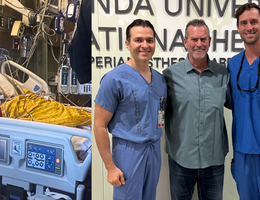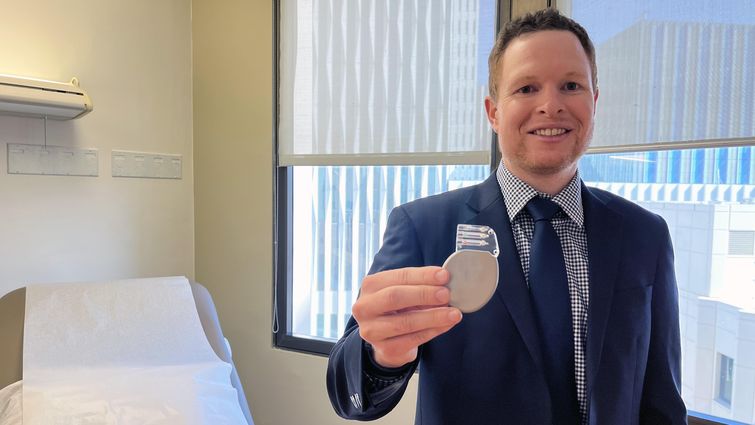

Brennan Rigby, MD, an electrophysiology fellow at Loma Linda University Medical Center, holds an implantable defibrillator. Such defibrillators monitor and treat abnormal heart rhythms which can lead to sudden cardiac arrest.
Sudden cardiac arrest (SCA) is the third leading cause of death in the U.S., affecting over 350,000 people each year — with only 1 in every 10 victims surviving — according to the Sudden Cardiac Arrest Foundation.
SCA is when the heart stops beating and leads to a loss of blood flow to the brain, lungs, and other vital organs, says Brennan Rigby, MD, an electrophysiology fellow at Loma Linda University Medical Center. SCA often occurs abruptly and unexpectedly, says Rigby, who stresses the importance of knowing about SCA risk factors and prevention before encountering an SCA-related incident.
For October’s Sudden Cardiac Arrest Awareness Month, Rigby discusses some of the most common risk factors for SCA and what steps to take to reduce one’s risk of experiencing sudden cardiac arrest.
Know your risk
Rigby says most risk factors for SCA are related to underlying cardiac conditions or events, such as coronary artery disease, cardiomyopathies, valvular heart disease, abnormal heart rhythms, myocarditis, and certain genetic conditions. Additionally, he says factors like hypertension, diabetes, and obesity affect heart health and can increase the likelihood of SCA.
“Understanding your risk factors for sudden cardiac arrest is critical in safeguarding your heart health,” Rigby says.
He urges all patients to talk to their care providers about conditions that heighten the risk of SCA. He also encourages patients to speak with their families to learn about any relatives who have had sudden cardiac or unexplained death. Rigby describes some of the top risk factors:
- Coronary artery disease (CAD) is the most common risk factor for SCA and occurs when the blood vessels supplying blood to the heart become narrow or blocked. This reduces blood flow to the heart, increasing the risk of SCA.
- Nonischemic cardiomyopathies, or heart muscle disorders in the absence of blocked arteries, can also increase the risk of SCA. These disorders can occur due to genetic mutations, viral infections, autoimmune conditions, and certain medications.
- Some of the genetic conditions that can lead to dangerous heart arrhythmias include: Hypertrophic Cardiomyopathy (HCM), Arrhythmogenic Right Ventricular Dysplasia/Cardiomyopathy (ARVC/D), Long QT Syndrome (LQTS), and Brugada Syndrome (BS).
- Certain arrhythmias, such as ventricular fibrillation (VF) and ventricular tachycardia (VT), decrease the heart’s ability to pump blood efficiently and significantly increases the risk of SCA.
- A previous heart attack indicates underlying heart disease, which can lead to electrical abnormalities in the heart's rhythm and increase the risk for SCA.
“Knowing one’s risk factors for sudden cardiac arrest is important because it allows patients and their health providers to tailor care and interventions to minimize potential threats to heart health,” Rigby says.
Reduce your risk
Rigby says patients should partner with health providers to take an active role in reducing their risk of SCA.
“By understanding risk factors for SCA, physicians can work together with patients to implement targeted preventive or risk-reducing measures,” he says. He reviews some basic steps patients can take to reduce their SCA risk:
- Establish care with a health provider. Health providers can help you understand and assess your risk for SCA by conducting essential screenings, monitoring heart health, and providing guidance on lifestyle changes. Additionally, they may prescribe medications or interventions to ensure timely and effective management of any underlying heart conditions.
- Know your family history, and share it with your health provider. A family history of SCA or cardiac events such as heart attacks indicates a potential genetic predisposition to heart conditions that can lead to SCA. Therefore, knowing one's family history of SCA or heart-related conditions is crucial for risk management.
- Grow awareness and understanding of defibrillators. These specialized devices deliver an electric shock to the heart during a life-threatening arrhythmia, restoring a normal heartbeat. For individuals at elevated SCA risk, having access to a defibrillator can be a lifesaving intervention in a cardiac emergency.
- Consider genetic counseling if deemed appropriate by your healthcare provider. This tool can provide patients insights into whether they have any genetic predispositions to conditions that heighten SCA risk. Based on their results, patients will work with their providers to determine the best path forward for heart care.
- Engage in a heart-healthy lifestyle to maintain optimal cardiovascular health. Regular exercise, a balanced diet, and smoking cessation can each reduce risk factors for SCA, such as high blood pressure, diabetes, high cholesterol, and obesity.
At Loma Linda University International Heart Institute, physicians are committed to providing patients with compassionate, comprehensive, and personalized cardiovascular care. To learn more, please visit lluh.org/heart-vascular or call 1-800-468-5432 to make an appointment.

